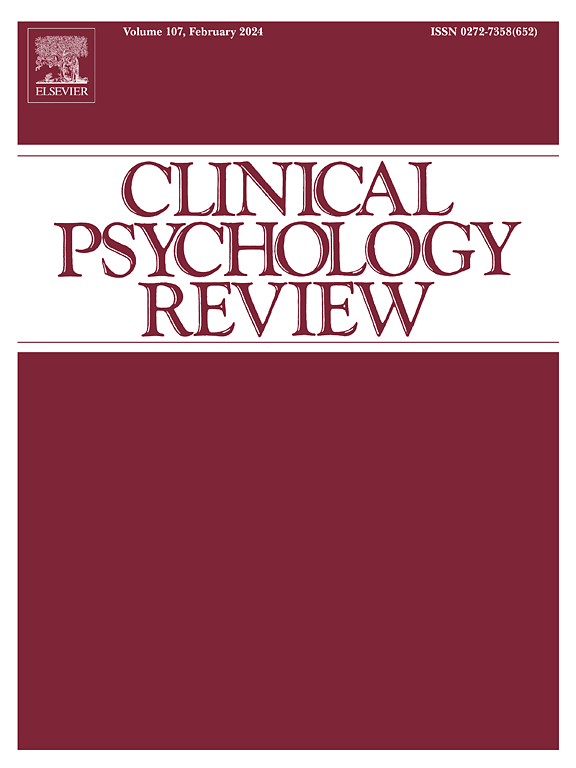Global PTSD prevalence among active first responders and trends over recent years: A systematic review and meta-analysis
IF 12.2
1区 心理学
Q1 PSYCHOLOGY, CLINICAL
引用次数: 0
Abstract
First responders in emergency services are inherently exposed to potentially psychologically traumatic events, increasing their risk for PTSD, burnout, and work incapacity. The current meta-analysis aimed to comprehensively compare PTSD prevalence within varied first responders in the context of both routine exposures and large-scale disasters, assess trends over recent years and differences between economic contexts. In January 2025, five databases were searched for peer-reviewed observational studies on employed or volunteering samples. Publication date was limited to post-2008, given meta-analyses addressing similar questions captured literature until this point. Random effects meta-analyses and meta-regressions explored trends over time and the impacts of exposure category, occupation, economic context, volunteer status, sex, and PTSD measurement. Analyses included 138 studies (173 independent samples). General samples with routine exposures possessed greater prevalence (14.3 %) than samples exposed to large-scale disasters (8.3 %). For the first time, there was some evidence of increasing prevalence over time within routine exposure samples. Low/middle-income countries and non-volunteers exhibited greater PTSD prevalence than high-income countries and volunteers. Prevalence varied based on PTSD outcome measurement, although no differences emerged between occupational and sex subgroups. Increasing PTSD prevalence over time appears to have been largely driven by increases observed since the COVID-19 pandemic, yet important questions remain regarding why prevalence has not decreased in relation to increasing efforts to support this population's mental health. All first responder occupations appear equally prone to PTSD, and thus equally in need of intervention. Workers in low/middle-income countries are particularly vulnerable to PTSD, potentially due to more limited resourcing.
全球创伤后应激障碍患病率在积极的第一响应者和趋势近年来:一个系统的回顾和荟萃分析
急救服务的第一响应者天生就暴露在潜在的心理创伤事件中,增加了他们患创伤后应激障碍、倦怠和丧失工作能力的风险。当前的荟萃分析旨在全面比较常规暴露和大规模灾难背景下不同急救人员的PTSD患病率,评估近年来的趋势和经济背景之间的差异。2025年1月,在五个数据库中搜索了同行评议的关于受雇或志愿者样本的观察性研究。发表日期限于2008年后,因为元分析解决了类似的问题,并在此之前捕获了文献。随机效应荟萃分析和荟萃回归探讨了随时间变化的趋势以及暴露类别、职业、经济背景、志愿者状态、性别和创伤后应激障碍测量的影响。分析包括138项研究(173个独立样本)。常规暴露的一般样本的患病率(14.3 %)高于暴露于大规模灾害的样本(8.3 %)。这是第一次有证据表明,在常规接触样本中,随着时间的推移,患病率增加。中低收入国家和非志愿者的PTSD患病率高于高收入国家和志愿者。尽管职业亚组和性别亚组之间没有差异,但PTSD的患病率因结果测量而有所不同。随着时间的推移,创伤后应激障碍患病率的上升似乎在很大程度上是由COVID-19大流行以来观察到的上升所驱动的,但关于为什么在支持这一人群心理健康的努力不断加大的情况下,患病率没有下降,仍然存在重要问题。所有的第一反应职业似乎都同样容易出现PTSD,因此同样需要干预。低收入/中等收入国家的工人特别容易患创伤后应激障碍,可能是由于资源更有限。
本文章由计算机程序翻译,如有差异,请以英文原文为准。
求助全文
约1分钟内获得全文
求助全文
来源期刊

Clinical Psychology Review
PSYCHOLOGY, CLINICAL-
CiteScore
23.10
自引率
1.60%
发文量
65
期刊介绍:
Clinical Psychology Review serves as a platform for substantial reviews addressing pertinent topics in clinical psychology. Encompassing a spectrum of issues, from psychopathology to behavior therapy, cognition to cognitive therapies, behavioral medicine to community mental health, assessment, and child development, the journal seeks cutting-edge papers that significantly contribute to advancing the science and/or practice of clinical psychology.
While maintaining a primary focus on topics directly related to clinical psychology, the journal occasionally features reviews on psychophysiology, learning therapy, experimental psychopathology, and social psychology, provided they demonstrate a clear connection to research or practice in clinical psychology. Integrative literature reviews and summaries of innovative ongoing clinical research programs find a place within its pages. However, reports on individual research studies and theoretical treatises or clinical guides lacking an empirical base are deemed inappropriate for publication.
 求助内容:
求助内容: 应助结果提醒方式:
应助结果提醒方式:


